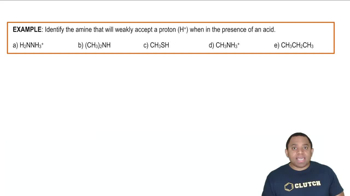The value of Ka for nitrous acid (HNO2) at 25 °C is given in Appendix D. (b) By using the value of Ka, calculate ΔG° for the dissociation of nitrous acid in aqueous solution.
Ch.19 - Chemical Thermodynamics

Brown15th EditionChemistry: The Central ScienceISBN: 9780137542970Not the one you use?Change textbook
Chapter 19, Problem 84a
The Kb for methylamine (CH3NH2) at 25 °C is given in Appendix D. (a) Write the chemical equation for the equilibrium that corresponds to Kb.
 Verified step by step guidance
Verified step by step guidance1
Identify the base in the problem: Methylamine (CH_3NH_2) is a weak base.
Recall that the base dissociation constant, K_b, is related to the equilibrium of a base reacting with water.
Write the chemical equation for the reaction of methylamine with water: CH_3NH_2 + H_2O \rightleftharpoons CH_3NH_3^+ + OH^-.
Recognize that in this equilibrium, methylamine accepts a proton from water, forming the methylammonium ion (CH_3NH_3^+) and hydroxide ion (OH^-).
Ensure the equation is balanced and represents the equilibrium process for which K_b is defined.

Verified video answer for a similar problem:
This video solution was recommended by our tutors as helpful for the problem above.
Video duration:
2mWas this helpful?
Key Concepts
Here are the essential concepts you must grasp in order to answer the question correctly.
Equilibrium Constant (K_b)
The base dissociation constant, K_b, quantifies the strength of a base in solution. It is defined as the ratio of the concentration of the products to the concentration of the reactants at equilibrium for the reaction of a base with water. A higher K_b value indicates a stronger base, as it suggests a greater tendency to accept protons.
Recommended video:
Guided course

Equilibrium Constant K
Chemical Equilibrium
Chemical equilibrium occurs when the rates of the forward and reverse reactions are equal, resulting in constant concentrations of reactants and products. In the context of a base like methylamine, this means that the formation of hydroxide ions and the conjugate acid reaches a stable state where their concentrations no longer change over time.
Recommended video:
Guided course

Chemical Equilibrium Concepts
Methylamine as a Base
Methylamine (CH₃NH₂) is an organic compound that acts as a weak base in aqueous solution. When dissolved in water, it can accept a proton (H⁺) from water, leading to the formation of its conjugate acid (methylammonium ion, CH₃NH₃⁺) and hydroxide ions (OH⁻). This reaction is essential for writing the equilibrium expression for K_b.
Recommended video:
Guided course

Base Example
Related Practice
Textbook Question
Textbook Question
The value of Ka for nitrous acid (HNO2) at 25 °C is given in Appendix D. (c) What is the value of ΔG at equilibrium?
Textbook Question
The value of Ka for nitrous acid (HNO2) at 25 °C is given in Appendix D. (d) What is the value of ΔG when [H+] = 5.0⨉10-2 M, [NO2-] = 6.0⨉10-4 M, and [HNO2] = 0.20 M?
Textbook Question
The Kb for methylamine (CH3NH2) at 25 °C is given in Appendix D. (d) What is the value of ΔG when [H+] = 6.7 × 10-9 M, [CH3NH3+] = 2.4 × 10-3 M, and [CH3NH2] = 0.098 M?
Textbook Question
(a) Which of the thermodynamic quantities T, E, q, w, and S are state functions? (b) Which depend on the path taken from one state to another?
1
views
Textbook Question
(d) For a reversible isothermal process, write an expression for ΔE in terms of q and w and an expression for ΔS in terms of q and T.
